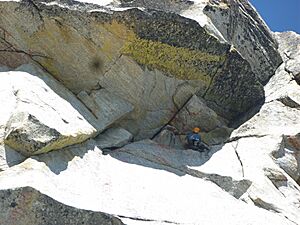Prusik Peak facts for kids
Quick facts for kids Prusik Peak |
|
|---|---|

Prusik Peak seen from Gnome Tarn
|
|
| Highest point | |
| Elevation | 8,000 ft (2,400 m) |
| Prominence | 160 ft (49 m) |
| Geography | |
| Location | Chelan County Washington state, U.S. |
| Parent range | Cascade Range |
| Topo map | USGS Enchantment Lakes |
| Type of rock | Granite |
| Climbing | |
| First ascent | May 1948 by Fred Beckey and Art Holben |
| Easiest route | Climbing class 5.6 |
Prusik Peak is a tall, rocky mountain in Washington state. It stands over 8,000 feet high! This amazing peak is made of granite, a very hard rock. You can find it in Chelan County.
Prusik Peak is a famous part of a beautiful area called The Enchantments. It's also within the Alpine Lakes Wilderness. Many people take pictures of Prusik Peak because it looks so cool. It's often seen as a symbol of these wild places. This peak is part of the Stuart Range, which is a smaller part of the huge Cascade Range.
The mountain is named after Dr. Karl Prusik. He was an Austrian mountain climber. He invented a special rope knot called the prusik knot. This knot was actually used to help climbers reach the top of Prusik Peak for the very first time in 1948! That first climb was done by Fred Beckey. Water from the peak flows into Icicle Creek, which then joins the Wenatchee River.
Weather at Prusik Peak
The weather around Prusik Peak is mostly shaped by the Pacific Ocean. Big weather systems, called weather fronts, usually start over the ocean. They then travel east towards the Cascade Mountains.
When these weather fronts hit the tall Cascade Mountains, they are forced to rise. As the air goes up, it cools down. This causes the moisture in the air to turn into rain or snowfall. This process is called Orographic lift. Because of this, the Cascade Mountains get a lot of rain and snow, especially in winter.
Winters are often cloudy. But in summer, high-pressure systems over the Pacific Ocean bring clear skies. This means there's often little to no cloud cover. The snow here tends to be wet and heavy. This can make the risk of avalanches higher.
How Prusik Peak Was Formed
The Alpine Lakes Wilderness has some very rugged land. You can see sharp peaks, long ridges, and deep valleys carved by glaciers. There are also huge granite walls and more than 700 mountain lakes!
The amazing landscape and big changes in height were created by geological events. These events happened millions of years ago. The story of the Cascade Mountains began a very long time ago, in the late Eocene Epoch.
The Earth's surface is made of huge pieces called plates. The North American Plate slowly moved over the Pacific Plate. This movement caused a lot of volcanic activity. Also, small pieces of the Earth's outer layer, called terranes, helped form the North Cascades. This happened about 50 million years ago.
Later, during the Pleistocene period, which was over two million years ago, huge sheets of ice called glaciers moved across the land. These glaciers moved forward and then melted back many times. As they moved, they scraped away the land. They left behind piles of rock and dirt.
The last time glaciers melted in the Alpine Lakes area was about 14,000 years ago. The valleys here have a "U" shape. This shape was carved out by those powerful glaciers. The mountains were also pushed up by forces inside the Earth (uplift). Cracks in the Earth's crust (faulting) also played a role. These processes, along with glaciation, created the tall peaks and deep valleys we see today.
Climbing Prusik Peak
Many people enjoy rock climbing on Prusik Peak. Here are some of the established climbing paths:
- East Route – This was the first path climbed in 1948.
- West Ridge – This route is rated class 5.7 and has 4 sections. It was first climbed in 1957.
- South Face Beckey-Davis Route – This path is rated class 5.9 and has 7 sections. It was first climbed in 1962.
- Stanley-Burgner Route – This route is rated class 5.10a and has 6 sections. It was first climbed in 1968.
- Solid Gold – This path is rated class 5.11a and has 5 sections. It was first climbed in 1989.
- Der Sportsman – This route is rated class 5.11+ and has 6 sections.




